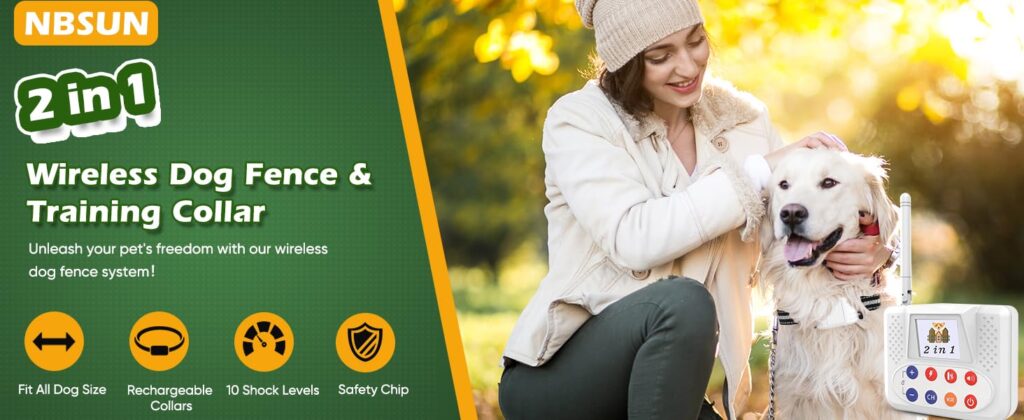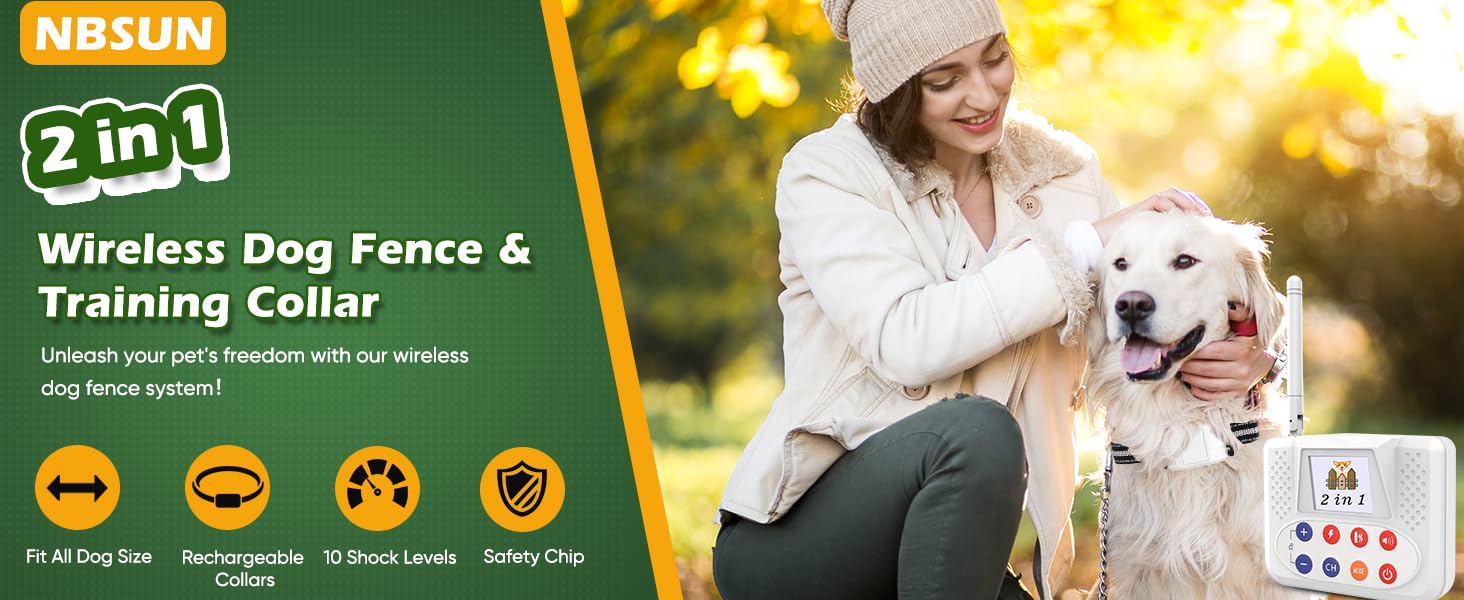
Unleashed Freedom: Choosing the Best Wireless Fence for Dogs with Large Areas
For dog owners with expansive properties, keeping their furry companions safe and contained can be a significant challenge. Traditional fencing can be costly, time-consuming to install, and aesthetically unappealing. A wireless fence for dogs large area offers a convenient and often more affordable alternative. But with numerous options available, how do you choose the best system to suit your dog’s needs and your property’s characteristics? This article delves into the world of wireless dog fences, focusing on models designed for larger areas, exploring their benefits, limitations, key features to consider, and providing expert recommendations to help you make an informed decision.
Understanding Wireless Dog Fences: How They Work
Unlike physical fences, a wireless fence for dogs large area, also known as an electronic or invisible fence, relies on radio frequency (RF) technology to create a virtual boundary. The system typically consists of two main components: a transmitter and a receiver collar. The transmitter emits a radio signal that forms a circular boundary around it. The receiver collar, worn by your dog, detects this signal. When your dog approaches the boundary, the collar emits a warning tone, prompting them to turn back. If the dog continues past the warning zone, the collar delivers a static correction, also known as a shock, which serves as a deterrent.
The range of a wireless fence for dogs large area can be adjusted, allowing you to customize the boundary to suit your property’s size. Some systems offer a circular boundary with a radius of up to several hundred feet, covering multiple acres. More advanced systems offer customizable shapes and allow for the creation of exclusion zones, keeping your dog away from specific areas like gardens or pools.
Benefits of a Wireless Fence for Large Properties
Choosing a wireless fence for dogs large area offers several advantages over traditional fencing, particularly for expansive properties:
- Cost-Effectiveness: Wireless fences are generally less expensive than traditional fences, especially when covering large areas. The cost of materials and labor for installing a physical fence can be substantial.
- Ease of Installation: Wireless fences are relatively easy to install. The transmitter simply needs to be placed indoors and plugged into a power outlet. No digging or post-setting is required.
- Aesthetics: Wireless fences are virtually invisible, preserving the natural beauty of your property. They don’t obstruct views or detract from the landscape.
- Portability: Wireless fences can be easily moved and reconfigured, making them ideal for travel or temporary situations.
- Customization: Many wireless fence for dogs large area systems offer adjustable boundaries and exclusion zones, allowing you to tailor the system to your specific needs.
Limitations and Considerations
While a wireless fence for dogs large area offers numerous benefits, it’s essential to be aware of its limitations:
- Reliance on Technology: Wireless fences rely on radio signals, which can be affected by interference from other electronic devices or physical obstructions. This can lead to inconsistent boundary performance.
- Training Required: Proper training is crucial for a wireless fence to be effective. Your dog needs to understand the warning signals and the consequences of crossing the boundary.
- Static Correction: The static correction can be a concern for some dog owners. While the level of correction is adjustable, some dogs may be more sensitive to it than others.
- Escape Artists: Determined dogs may be able to breach the boundary despite the static correction. Breeds with a high prey drive or a strong desire to roam may require additional training or a different containment solution.
- Battery Dependence: The receiver collar requires batteries, which need to be replaced or recharged regularly. A dead battery renders the system ineffective.
Key Features to Consider When Choosing a Wireless Fence
When selecting a wireless fence for dogs large area, consider the following features:
Range and Coverage Area
Ensure the system’s range is adequate for your property size. Check the maximum radius or diameter of the boundary and whether it can be adjusted to fit your specific needs. Some systems also allow for the creation of multiple zones or customized shapes.
Collar Size and Adjustability
Choose a collar that is appropriately sized for your dog’s breed and weight. The collar should fit snugly but comfortably around your dog’s neck. Ensure the collar is adjustable to accommodate growth or changes in weight.
Correction Levels
Opt for a system that offers multiple correction levels, allowing you to customize the intensity of the static correction. Start with the lowest level and gradually increase it as needed. Some systems also offer a vibration-only mode for training purposes.
Battery Life
Consider the battery life of the receiver collar. Longer battery life means less frequent replacements or recharges. Look for collars with low-battery indicators to avoid unexpected system failures.
Water Resistance
Choose a collar that is waterproof or water-resistant, especially if your dog enjoys swimming or spends time outdoors in wet conditions. This will prevent damage to the collar and ensure its continued functionality.
Interference Resistance
Some wireless fence for dogs large area systems are designed with advanced technology to minimize interference from other electronic devices. This can improve the reliability and consistency of the boundary signal.
Training Features
Look for systems that include training flags or other aids to help your dog learn the boundaries. Some systems also offer online training resources or customer support to assist you with the training process. [See also: Dog Training Tips for Wireless Fences]
Top Wireless Fence Recommendations for Large Areas
Here are a few highly-rated wireless fence for dogs large area systems that are well-suited for expansive properties:
- PetSafe Stay & Play Wireless Fence: This system offers a circular boundary with an adjustable range of up to 105 feet in all directions from the base unit, making it suitable for yards up to ¾ acre. It features five adjustable levels of static correction, plus a tone-only mode.
- Extreme Dog Fence: Known for its durability and reliability, the Extreme Dog Fence system can cover up to 25 acres with additional wire and flags. It offers multiple correction levels and customizable boundary shapes. [See also: Extreme Dog Fence Installation Guide]
- SpotOn GPS Fence: A GPS-based system, the SpotOn Fence allows you to create custom-shaped boundaries using your smartphone. It offers accurate and reliable containment, even in challenging terrain.
Training Your Dog to Use a Wireless Fence
Proper training is essential for a wireless fence for dogs large area to be effective. Follow these steps to train your dog:
- Introduce the Collar: Let your dog wear the receiver collar for short periods, gradually increasing the time as they get used to it.
- Flag Training: Place training flags along the boundary line. Walk your dog along the boundary, rewarding them when they stay within the flags.
- Warning Tone: Allow your dog to hear the warning tone by approaching the boundary. When they hear the tone, gently guide them back inside the boundary and reward them.
- Static Correction: If your dog crosses the boundary despite the warning tone, they will receive a static correction. Immediately guide them back inside the boundary and reassure them.
- Consistent Reinforcement: Continue to reinforce the training regularly, even after your dog understands the boundaries.
Troubleshooting Common Issues
Even with proper training, you may encounter some issues with your wireless fence for dogs large area. Here are some common problems and how to address them:
- Dog Ignoring the Correction: Increase the correction level gradually until your dog responds. Ensure the collar is fitting properly and making good contact with your dog’s skin.
- Inconsistent Boundary: Check for interference from other electronic devices or physical obstructions. Try repositioning the transmitter or adjusting the signal strength.
- Collar Not Working: Check the battery and replace it if necessary. Ensure the collar is turned on and properly programmed.
Is a Wireless Fence Right for Your Dog?
A wireless fence for dogs large area can be a convenient and cost-effective solution for containing your dog on a large property. However, it’s important to consider your dog’s temperament, training ability, and any potential limitations of the system. If you’re unsure whether a wireless fence is right for your dog, consult with a professional dog trainer or veterinarian.
Conclusion
Choosing the right wireless fence for dogs large area requires careful consideration of your property size, your dog’s needs, and the features of the available systems. By understanding the benefits and limitations of wireless fences, and by following proper training techniques, you can provide your dog with the freedom to roam safely and securely on your property. Remember to prioritize safety and choose a system that is appropriate for your dog’s temperament and training level. With the right wireless fence, you can enjoy peace of mind knowing that your furry friend is safe and contained.

